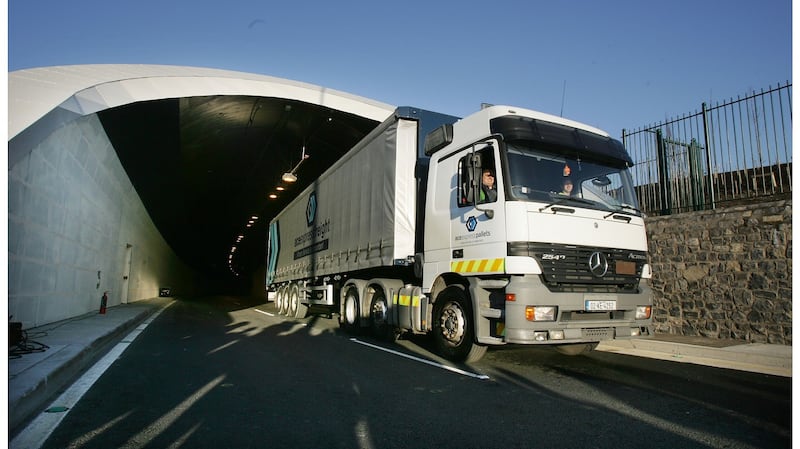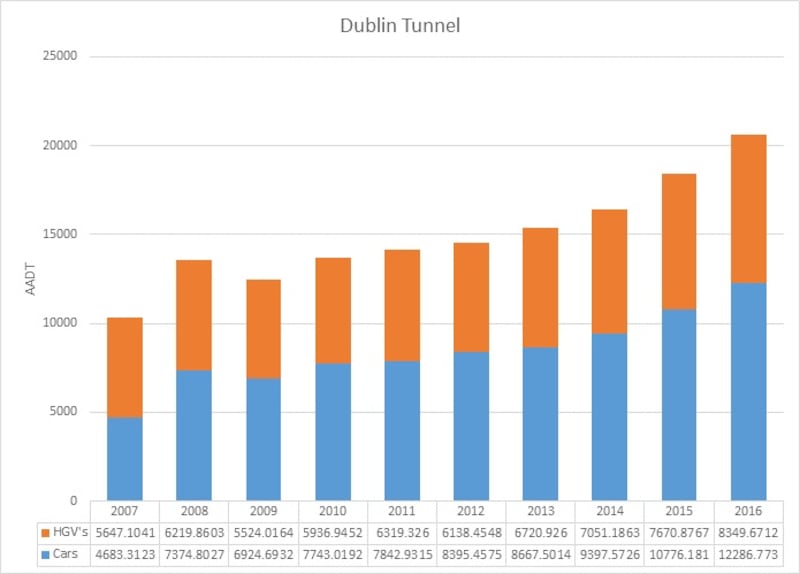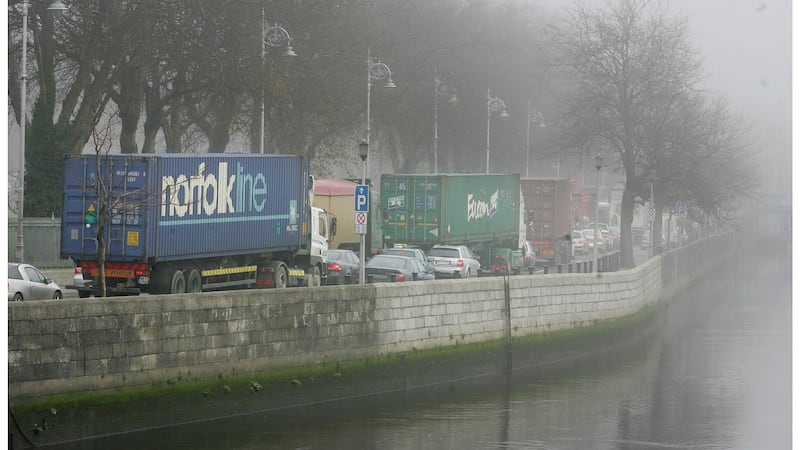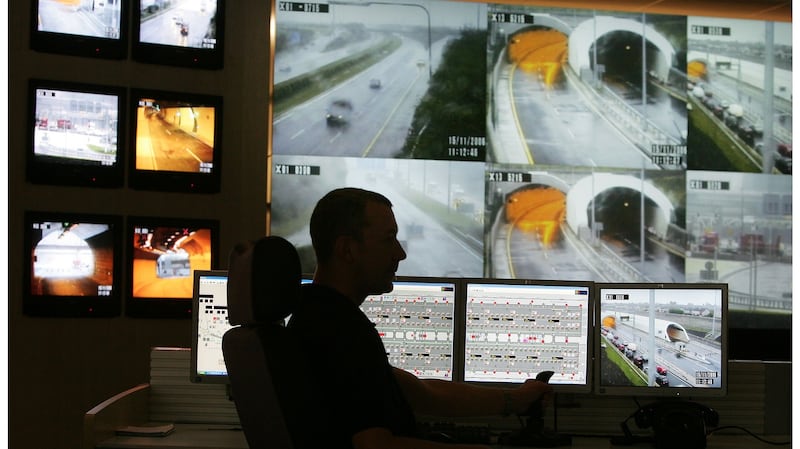Cutting the ribbon at the opening of the Dublin Port Tunnel, a dozen years after it was sanctioned and five years after construction began, Bertie Ahern joked: “If there’s not a 10-year row about a project, it’s not worth doing.”
And there were many rows. It was constantly opposed by residents in Marino, with the Marino Development Action Group describing the plan as "not just imperfect, but totally wrong".
In October 2000, Finian McGrath, then an Independent councillor for north central Dublin, was scathing: “It’s a PR and con trick to try to create an image that they’re going to deal with traffic,” he claimed.
Meanwhile, the Irish Road Haulage Association (IRHA) complained that the tunnel's height would would be too low for many lorries and that plans to exclude trucks from the city centre would strangle Dublin.

Shortly after tunnelling work got under way, residents in Marino complained as tiles broke and cracks appeared on the walls of their homes. Noise and vibrations from the work below ground could be felt too.
By July 2005, the tunnel was projected to cost Dublin City Council millions in compensation repairs.
By then, the local authority had received more than 1,500 complaints.
Looking back today, as it celebrates it 10th year, Bertie Ahern is, frankly, scathing of the critics: “All the great and the good were opposed to it in the early years. I went to all the meetings myself down in Marino and Fairview.
“There were scaremongers who used it as a thing to be against. It was all to be a disaster and it was a con job. The paths would never be put back again. Fairview Park with all the lovely tulips and daffodils would never be seen again.
View of ‘begrudgers’
“That didn’t happen,” says Ahern, with evident satisfaction, saying that the “largest piece of infrastructure ever delivered in Ireland” had been successfully completed in spite of “begrudgers”.
The first HGVs entered from the port shortly before 11am on the day of its opening and made a ceremonial journey down the north bore and back up the south in just over 10 minutes.

Looking back now, Ahern remembers the opposition: “ The main criticisms were that the houses would fall into the hole, and there would be floods all the time.
“Anytime the newspapers were having a slow day, they would send a photographer out to try and get a shot of a bucket of water or something so they could run another piece about the floods in the tunnel.
Once it was opened, all opposition vanished.
“From the day I officially opened it, I don’t think I got another call on it,” he says.
“Even those who were opposed to it at the time turned around and openly congratulated me.
“From 7am on Griffith Avenue, there would be lines of trucks. Now you come out, and there’s nothing there. It eliminated all of that and there was never a dicky bird again,” he goes on.

The difference it has been made is illustrated by an image: an 80km-long line of trucks weighing up to 36 tonnes apiece snaking its way through Dublin city centre hour by hour, each and every day.
Now celebrating its 10th-anniversary year, the twin-bore 4.5km-long, 4.65m high tunnel links with the M50 motorway, completing the northern part of the C-Ring around Dublin city.
Vital infrastructure
Designed as a dedicated route for heavy goods vehicles leaving Dublin Port, it was described by Ibec in 1996 as “the single most important piece of national transport infrastructure within the last decade”.
In October of the same year, Dublin City Council moved to introduce a 12-hour daytime ban on HGVs in the city centre area between the Royal and Grand canals following the tunnel’s opening.
The ban would apply to all HGVs of five axles and over – some 65 per cent of lorries using Dublin Port.
Criticising the plan, the IRHA said it would lead to “the strangulation of commercial life of the city”, forcing lorries which arrive at the port at 7am to wait up to 12 hours before entering the city centre.
Nearing completion in June 2006, there were calls for it to be named the Charles Haughey Tunnel.
Shortly after Haughey’s death, Minister for Transport Martin Cullen said he had “no problem” with the idea, but Labour’s Sean Kenny rejected the call as “a piece of political opportunism”.

When first approved by Dublin City Council in 1996, it was said that the tunnel could be built for £130 million.
The final cost came in at €789 million in 2010 after after a legal claim by the construction consortium that built it was settled.
The tunnel opened to private cars for the first time on January 28th, 2007. Drivers were forced to pay a toll ranging from €3 to €12. On February 19th, 2007, the promised ban on five-axle HGVs came into force.
On June 27th, 2007, the one-millionth truck passed through the tunnel. Just six months after the opening, NRA figures showed more than 1.5 million cars, trucks and buses had used it. Trucks numbers in the city fell n by 94 per cent.
Today, 20,000 trucks and cars used the tunnel daily, say Sean O’Neill of Transport Infrastructure Ireland, which runs the tunnel: “The traffic in the tunnel correlates almost exactly with the economic activity in the State,” he says.
‘Cheap as chips’
AA spokesman Conor Faughnan says the tunnel has been of "enormous benefit" to the city.
“I don’t know how you’d even begin to calculate it,” he says. “I remember being involved in the debates. As we look back now, it looks cheap as chips.
“It’s been a fantastic asset to Dublin and there are various ways that has manifested itself. It allowed us to introduce the five-axle ban in Dublin city centre and remove all those trucks. I’m not sure people remember just how bad that was.
“All the trucks had to trundle through the quays, and they created a wall of steel up and down the city, often at very inappropriate times of the day. That meant enormous congestion.”
Faughnan says the tunnel has “humanised” the city. “It’s made it a much safer environment for cyclists for example. There is now twice the number of cyclists in Dublin city centre than there was when the tunnel opened.”
Brendan O’Brien, who has been Dublin City Council head of technical services for traffic since 2002, was involved in drawing up the traffic management strategy for after the tunnel opened.
“If you take the East Wall Road running up to Alfie Byrne Road, the number of HGVs that still use that road in one month is the same as the number that used to use it in just one day,” he says.
“If you take the city itself in terms of five-axle trucks, we’ve roughly about 4,500 of those removed from the city on a daily basis. That roughly represents about 80km of trucks. It’s been hugely significant.
“Once we were able to remove all these trucks from the city centre, it became more conducive for pedestrians and cyclists.
“In 2009, we introduced the Dublin bike scheme, which probably couldn’t have happened without the port tunnel.”
‘Essential life line’
Dublin Port chief executive Eamonn O’Reilly says the tunnel has become “the essential life line” for the port.
“If it hadn’t been built, I can’t imagine how the port would be operating today,” he says. “Our growth is enormous. In the last four years, we have increased by 25 per cent in volume.
“The fundamental driver for the increase in trade is the growth in the economy.
“We typically go up by about 1.4 times gross domestic product. Dublin is the gateway port for the economy of the country. About 80 per cent of the high value stuff comes through Dublin Port.
“As the economy increases, our volumes increase. The important thing the tunnel did is it allowed the port to satisfy that demand without bringing the city and surrounding areas to a complete standstill.”
More infrastructure spending is needed, says O’Reilly; “We are happy as long as freight is prioritised over cars. There is plenty of capacity in the tunnel to cater for growth in Dublin Port’s volumes out to 2040.
“At that stage, I think we’re going to max out in Dublin Port itself, and we’re going to have to look at building new port facilities either north or south of Dublin.”
Progress continues
Developments at the tunnel are still coming today. Long-heralded speed detection cameras have been installed in the tunnel, though they have not yet come into force.
The cameras, which have been installed at either end of the north- and south-bound bores, are designed to calculate how fast a vehicle is travelling by measuring the time it takes to cover a specified distance.
Any vehicle passing through the tunnels in less than three minutes and 20 seconds will be deemed to have been travelling faster than the 80km/h speed limit, once the speed rules are in force.
Looking ahead, Ibec bead of infrastructure, energy, and environment policy Neil Walker says the business lobby is anticipating the next phase of infrastructure.
“This will involve linking regions to one another via an integrated road network, which will be of great benefit to businesses around the country.”
DUBLIN TUNNEL: THE DRILL
* It is called the Dublin Tunnel, not the Dublin Port Tunnel.
* The “tunnel” is actually two separate tunnels which vary in distance between 10-15m from one another, located at a variable depth of between 20 and 30m below ground.
* The tunnels are linked every 250m to provide pedestrian escape routes.
* There are four cross passages linking the tunnels for vehicles.
* There are two lanes of traffic in each direction with a speed limit of 80km/hr.
* The annual average daily traffic in 2016 was 20,363 vehicles. 12,287 were cars and 8,350 were heavy goods vehicles.
*The number of cars is increasing more rapidly than HGVS.
* The cost of using the tunnel varies for cars. Citybound in the morning at peak times it is €10.Outbound in the evening peak it is €10. At all other times/directions cost €3.
* HGVs travel free
* Dublin Tunnel opened to traffic on December 20th, 2006.
* It is 4.5km long with a height clearance of 4.65m.
* A control room is located near the south portal. Duty managers/officers and patrols are on duty 24/7, 365 days a year.
* Continuous CCTV with cameras is installed all along the tunnel.
* Emergency call niches are located all along the tunnel with emergency roadside telephones. Motorists can be notified about any event via the variable message signs, AM radio or by public address loudspeaker.
* In case of fire, the ventilation system will push the smoke in the direction of traffic flow, away from the fire to provide a “safe zone”.
* If there is an incident in one tunnel, motorists can evacuate via the emergency links to the other tunnel.
* Safety teams can access an incident scene from the no-incident tunnel and use the cross-passages between the two bores.
* A dedicated fire engine and crew is based at North Strand.
– TIM O’BRIEN



















